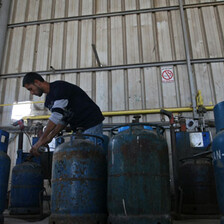Al-Ahram Weekly 16 March 2006

Palestinian women waiting at Tal Al-Soltan checkpoint in the Gaza Strip.Hatem Omar/Maan
The media reports that the Gaza Strip is no longer under Israeli control, but two weeks ago I was blocked from entering Gaza from Egypt by Israeli agents. The day before, two French citizens were prevented from entering for a sister city project in Gaza. Israeli authorities invoked “security reasons” and false claims of links to terrorism, a typical strategy used against foreign supporters of Palestinian rights. Despite the fanfare over Israel’s August “Gaza disengagement”, Gaza remains a prison, with no visitors allowed.
My case provides one small example, thousands of which are repeated every day, of how the Israeli government has exploited the cover of real security concerns to continue to control Gaza, denying Palestinians freedom and trapping them in poverty. Opportunities for progress through Israel’s Gaza withdrawal were squandered, and American promises on the Middle East were again shown to be empty.
In November, US Secretary of State Condoleezza Rice announced an agreement on Gaza’s borders that she brokered between the Israeli government and Palestinian Authority by saying, “this agreement is intended to give the Palestinian people freedom to move, to trade, to live ordinary lives.” But, as usual, the US government didn’t follow up after the press conference.
The agreement specified that bus and truck links between Gaza and the West Bank would open in December and January under Israeli supervision, but in December Israel suspended these plans indefinitely. Bus links or no, Israel denies permission for “security reasons” to Gazans — like my friend Laila, a journalist, mother, and fellow graduate of Harvard’s Kennedy School of Government — to travel to the West Bank.
Israel also agreed to “permit export of agricultural produce from Gaza and… facilitate its speedy exit and onward movement.” Instead, in January during peak harvest, Israel closed Karni, the primary commercial crossing, claiming militants were digging a tunnel in the area. After three weeks and millions of dollars of Palestinian losses, Israel re-opened Karni. No tunnel was ever found. Israel continues to close Karni regularly for “security reasons”.
The agreement promised steps towards establishing a seaport and re-opening Gaza’s airport. Israel has blocked progress on these fronts.
The single improvement is in movement through the Rafah border crossing between Gaza and Egypt. Palestinians possessing both passports and ID cards are eligible to cross through the Palestinian and Egyptian managed border. However, Israeli agents watching by video camera can raise “security reservations” about Palestinians or foreigners crossing, as they did in my case. If the PA overrides Israeli reservations, as is their right under the November agreements, Israel attacks them in the media for allowing “terrorists” into Gaza.
Some 50,000 Gaza residents who lack Israeli-approved ID cards cannot travel through Rafah, and Palestinian refugees from around the world must apply to enter Gaza. My friend Laila’s husband Yassin grew up in a Palestinian refugee camp in Lebanon and is now completing his medical internship in the United States. Israel could deny his application to visit his wife and two- year-old son in Gaza. A senior Palestinian civil servant says that the assertion that the Palestinians control Rafah crossing is “an illusion”.
Israel’s Gaza withdrawal provided opportunity to improve Palestinian lives and bolster Palestinian moderates, well before Hamas’s elections victory. Instead, the Israeli government maintained Gaza as a prison, and exploited the positive media surrounding the withdrawal to accelerate seizure of Palestinian West Bank land, rendering the creation of a viable Palestinian state impossible.
The failures surrounding the Gaza withdrawal exemplify why Hamas won the recent Palestinians elections. During the 12-year “peace process” illegal Israeli settlements doubled, Israeli military occupation continued and poverty deepened. So Palestinians voted out Fatah, the party that managed the failed peace process.
I stayed in Al-Arish, Egypt, while waiting for the decision on my entry to Gaza. It is 30 miles from Al-Arish to the border with Gaza — the same distance as the length of the entire Gaza Strip. Looking across the border a few weeks back, the contrast was dramatic. Around 1.4 million Palestinians are trapped in Gaza, one of the world’s most densely populated places. Just across the border here in Egypt in the same sized landmass, 230,000 people, some of them Palestinians with family in Gaza, live in relative peace and prosperity.
The conflict here is driven by the imprisonment of a people — the theft of their land and the denial of their basic rights. Israeli policies, and US complicity, are feeding desperation, and dimming hopes for achieving peace any time soon.
Patrick O’Connor is an occasional contributor to EI and an activist with the International Solidarity Movement in Palestine and New York City. O’Connor managed humanitarian aid programmes in Gaza, 1995-98, and supported Palestinian nonviolent resistance in the West Bank, 2002-05, with the International Solidarity Movement. He was imprisoned and deported from Israel after a peaceful West Bank protest in January 2005. This article was first published in the 16-22 March 2006 issue of Al-Ahram Weekly and is reprinted with the author’s permission.





